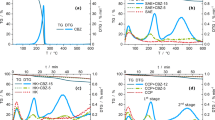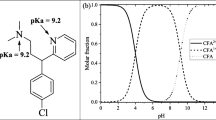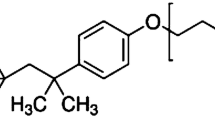Abstract
The effects of temperature, H2O2, and reuses on the performance of activated carbon for the decontamination of dilute tritiated water were investigated. The effects of these factors on the selective separation of HTO were divided into positive or negative aspects, and the effects were analyzed using the maximum partition coefficient. The increase in temperature had a negative effect on the selective separation, but the addition of H2O2 had a positive effect. Additionally, the reuse of activated carbon also had a negative effect, but it maintained a performance similar to that of fresh carbon until it was reused three times.








Similar content being viewed by others
References
Ono F, Nakazawa M, Takahashi Y, Kanno M (1980) Distribution equilibrium of tritium between adsorbed water on molecular sieve 5A and environmental water. J Nucl Sci Technol 17:721–723
Văsaru G (1993) Tritium Isotope Separation. CRC Press, Boca Raton, Ann Arbor, London, Tokyo
Allen WL (1995) Tritiated Wastewater Treatment and Disposal Evaluation for 1995. DOE/RL-95-68, United States Department of Energy
Taguchi A, Akai R, Saito M, Torikai Y, Matsuyama M, Ogura M, Uchida S (2011) Tritium removal from tritiated water using mesoporous silica. Fusion Sci Technol 60:1395–1398
Rana D, Matsuura T, Kassim MA, Ismail AF (2013) Radioactive decontamination of water by membrane processes — A Review. Desalination 321:77–92
Lozada-Hidalgo M, Zhang S, Hu S, Esfandiar A, Grigorieva IV, Geim AK (2017) Scalable and efficient separation of hydrogen isotopes using graphene-based electrochemical pumping. Nat Commun 8:1–5
Yeon J-W, Yang J, Kim T, Kim M, Cha W, Ha K (2021) Purification method for tritium-containing raw water and purification device therefor. Korean Patent 10:2236311–2230000
Selin I (1994) The 1993 NRC Annual Report. NUREG-1145, United States Nuclear Regulatory Commission, U.S Government Printing Office
Yamanishi T, Kakiuchi H, Tauchi H, Yamamoto T, Yamamoto I (2020) Discussions on tritiated water treatment for Fukushima Daiichi nuclear power station. Fusion Sci Technol 76:430–438
Rae HK (1978) In: Rae HK(ed) Separation of Hydrogen Isotopes, ACS Symposium Series, American Chemical Society, Washington, DC
Alekseev IA, Bondarenko SD, Fedorchenko OA, Konoplev KA, Vasyanina TV, Arkhipov EA, Uborsky VV (2005) Development of a heavy water detritiation plant for PIK reactor. Fusion Sci Technol 48:286–289
Bansal RC, Goyal M (2005) Activated Carbon Adsorption. Taylor & Francis, Boca Raton, London, New York, Singapore
Mingote RM, Barbeira PJS, Rocha Z (2006) Methodology for rapid tritium determination in urine. J Radioanal Nucl Chem 269:475–479
McCallum CL, Bandosz TJ, McGrother SC, Müller EA, Gubbins KE (1999) A molecular model for adsorption of water on activated carbon: Comparison of simulation and experiment. Langmuir 15:533–544
Acknowledgements
This work was supported by the Korean government (MSIT: the Ministry of Science and ICT) (NRF Nos. 2017M2A8A4015281, 2021M2E3A3040092, and RS-2022-00144202) and KAERI Institute Program (Project No. 522330-22).
Author information
Authors and Affiliations
Corresponding author
Ethics declarations
Conflict of interest
The authors declare that there is no conflict of interest.
Additional information
Publisher’s Note
Springer Nature remains neutral with regard to jurisdictional claims in published maps and institutional affiliations.
Electronic Supplementary Material
Below is the link to the electronic supplementary material.
Rights and permissions
Springer Nature or its licensor holds exclusive rights to this article under a publishing agreement with the author(s) or other rightsholder(s); author self-archiving of the accepted manuscript version of this article is solely governed by the terms of such publishing agreement and applicable law.
About this article
Cite this article
Yeon, JW., Yang, J. Effects of temperature and hydrogen peroxide on the selective adsorption of HTO on activated carbon in tritiated water. J Radioanal Nucl Chem 331, 4569–4576 (2022). https://doi.org/10.1007/s10967-022-08519-3
Received:
Accepted:
Published:
Issue Date:
DOI: https://doi.org/10.1007/s10967-022-08519-3




